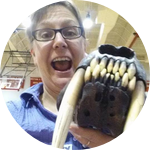Haven't created any projects yet!
Haven't backed any projects yet!
Sampling Tooth Enamel
In the previous post, I explained how teeth grow. Now I'm going to get into the details of how we collect tooth enamel samples for isotopic analysis. What we need is powdered enamel. The best way t...
How teeth grow
This is a post that I wrote on my blog in 2013 about how teeth grow. It's totally relevant to this project, because understanding how teeth form helps us interpret the results of the chemical analy...
I have this jaw I'd like to give you...
Part of this project is gathering the funds needed to perform the necessary chemical analyses. The other part is gathering jaw bones from far and wide (only legally, of course), so that we have a l...
Let's talk teeth - is this the third molar?
How do we know what teeth we have when we find a jaw or an isolated tooth?Let's start with a simple, yet common case: The lower jaw of a deer or sheep. For those of you that spend much time hiking,...
What chemistry?
As we describe this project, we refer to the "chemistry" of tooth enamel. Chemistry can mean a lot of things, so what does it mean in this context?Let's start with tooth enamel. Tooth enamel is com...
Some early data and how this works
This project was born from the practical need to be able to maximize our ability to learn about past environments using the geochemistry of fossil teeth. There have been a few studies, some publish...
